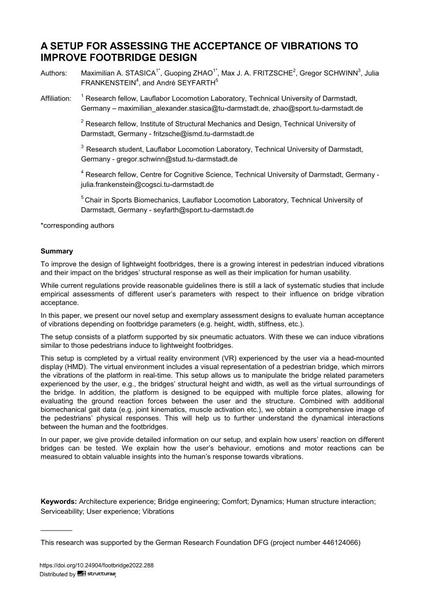A Setup for Assessing the Acceptance of Vibrations to Improve Footbridge Design

| Author(s): |
Maximilian A. Stasica
(Research fellow, Lauflabor Locomotion Laboratory, Technical University of Darmstadt, Germany)
Guoping Zhao (Research fellow, Lauflabor Locomotion Laboratory, Technical University of Darmstadt, Germany) Max J. A. Fritzsche (Research fellow, Institute of Structural Mechanics and Design, Technical University of Darmstadt, Germany) Gregor Schwinn (Research student, Lauflabor Locomotion Laboratory, Technical University of Darmstadt, Germany) Julia Frankenstein (Research fellow, Centre for Cognitive Science, Technical University of Darmstadt, Germany) André Seyfarth (Chair in Sports Biomechanics, Lauflabor Locomotion Laboratory, Technical University of Darmstadt, Germany) |
|---|---|
| Medium: | conference paper |
| Language(s): | English |
| Conference: | Footbridge 2022: Creating Experience, Madrid, Spain, 07-09 September 2022 |
| Published in: | Footbridge Madrid 2022 - Creating Experience |
| DOI: | 10.24904/footbridge2022.288 |
| Abstract: |
Comfort and acceptance are vital to user experience and therefore one of the main challenges in footbridge design. Due to the community’s current thrive towards efficient lightweight footbridges, pedestrian induced vibrations come into focus. This implies the need for empirical investigations of user experience on vibrating footbridges. In this paper, we present a setup that is simulating a vibrating surface. It consists of a movable platform coupled with a virtual reality based head mounted display to emulate varying bridge features (e.g. different heights, widths, surroundings). The user facing a bridge in the virtual environment experiences vibrations that are similar to those pedestrians induce on lightweight footbridges. These are mirrored in real-time in the virtual environment. As we combine this setup with additional biomechanical measurement equipment (Motion Capture, Ground Reaction Force Plates, and Electromyography) we obtain a comprehensive picture of the user’s physical response towards the respective bridge features. Our setup therefore yields the opportunity to further investigate the influence of vibrations and bridge features on the physical response of a user. The setup described can be used by researchers and bridge designers to assess and further enhance user experience on modern lightweight footbridges. |
| Keywords: |
comfort vibrations serviceability bridge engineering dynamics user experience human structure interaction Architecture experience
|
| License: | This creative work is copyrighted. The copyright holder(s) do(es) not grant any usage rights other than viewing and downloading the work for personal use. Further copying or publication requires the permission of the copyright holder(s). |
0.07 MB Download full text file (PDF)
0.33 MB
- About this
data sheet - Reference-ID
10667761 - Published on:
30/05/2022 - Last updated on:
01/06/2022



